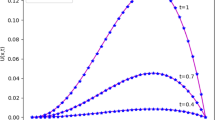Abstract
The accuracy of the central difference Nessyahu-Tadmor (NT) scheme is studied when calculating shock waves propagating at a variable velocity. It is shown that this scheme (in the construction of which the second-order MUSCL reconstruction of flows is used) has approximately the first order of both local convergence in the regions of influence of shock waves and integral convergence in intervals, one of the boundaries of which is in the region of influence of the shock wave. As a result, in these areas, the local accuracy of the NT scheme is significantly reduced. Test calculations are presented that demonstrate these properties of the NT scheme.




Similar content being viewed by others
REFERENCES
S. K. Godunov, “A difference method for numerical calculation of discontinuous solutions of the equations of hydrodynamics,” Mat. Sb. 89, 271–306 (1959).
B. van Leer, “Towards the ultimate conservative difference scheme. V. A second-order sequel to Godunov’s method,” J. Comput. Phys. 32, 101–136 (1979). https://doi.org/10.1016/0021-9991(79)90145-1
A. Harten, “High resolution schemes for hyperbolic conservation laws,” J. Comput. Phys. 49, 357–393 (1983). https://doi.org/10.1016/0021-9991(83)90136-5
A. Harten, S. Osher, “Uniformly high-order accurate nonoscillatory schemes. I,” SIAM J. Numer. Anal. 24, 279–309 (1987). https://doi.org/10.1137/0724022
G.-S. Jiang and C.-W. Shu, “Efficient implementation of weighted ENO schemes,” J. Comput. Phys. 126, 202–228 (1996). https://doi.org/10.1006/jcph.1996.0130
S. A. Karabasov and V. M. Goloviznin, “Compact Accurately Boundary-Adjusting high-REsolution Technique for fluid dynamics,” J. Comput. Phys. 228, 7426–7451 (2009). https://doi.org/10.1016/j.jcp.2009.06.037
V. V. Ostapenko, “Approximation of conservation laws by high-resolution difference schemes,” USSR Comput. Math. Math. Phys. 30 (5), 91–100 (1990). https://doi.org/10.1016/0041-5553(90)90165-O
V. V. Ostapenko, “A method of increasing the order of the weak approximation of the laws of conservation on discontinuous solutions,” Comput. Math. Math. Phys. 36, 1443–1451 (1996).
V. V. Ostapenko, “Construction of high-order accurate shock-capturing finite-difference schemes for unsteady shock waves,” Comput. Math. Math. Phys. 40, 1784–1800 (2000).
V. V. Ostapenko, “Convergence of finite-difference schemes behind a shock front,” Comput. Math. Math. Phys. 37, 1161–1172 (1997).
J. Casper and M. H. Carpenter, “Computational consideration for the simulation of shock-induced sound,” SIAM J. Sci. Comput. 19, 813–828 (1998).
B. Engquist and B. Sjögreen, “The convergence rate of finite difference schemes in the presence of shocks,” SIAM J. Numer. Anal. 35, 2464–2485 (1998).
O. A. Kovyrkina and V. V. Ostapenko, “On the convergence of shock-capturing difference schemes,” Dokl. Math. 82, 599–603 (2010). https://doi.org/10.1134/S1064562410040265
O. A. Kovyrkina and V. V. Ostapenko, “On the practical accuracy of shock-capturing schemes,” Math. Models Comput. Simul. 6 (2), 183–191 (2014). https://doi.org/10.1134/S2070048214020069
N. A. Mikhailov, “The convergence order of WENO schemes behind a shock front,” Math. Models Comput. Simul. 7, 467–474 (2015). https://doi.org/10.1134/S2070048215050075
O. A. Kovyrkina and V. V. Ostapenko, “On monotonicity and accuracy of CABARET scheme for calculating weak solutions with shocks,” Vychisl. Tekhnol. 23 (2), 37–54 (2018). https://doi.org/10.25743/ICT.2018.23.12757
H. Nessyahu and E. Tadmor, “Non-oscillatory central differencing for hyperbolic conservation laws,” J. Comput. Phys. 87, 408–463 (1990). https://doi.org/10.1016/0021-9991(90)90260-8
A. Kurganov and E. Tadmor, “New high-resolution central schemes for nonlinear conservation laws and convection-diffusion equations,” J. Comput. Phys. 160, 241–282 (2000). https://doi.org/10.1006/jcph.2000.6459
V. V. Ostapenko, Hyperbolic Systems of Conservation Laws and Their Application to the Theory of Shallow Water, 2nd ed. (Novosib. Gos. Univ., Novosibirsk, 2014) [in Russian].
V. V. Rusanov, “Difference schemes of the third order of accuracy for continuous computation of discontinuous solutions,” Sov. Math. Dokl. 9, 771–774 (1968).
V. V. Ostapenko, “On the finite-difference approximation of the Hugoniot conditions on a shock wave front propagating with variable velocity,” Comput. Math. Math. Phys. 38, 1299–1311 (1998).
O. A. Kovyrkina and V. V. Ostapenko, “On the construction of combined finite-difference schemes of high accuracy,” Dokl. Math. 97, 77–81 (2018). https://doi.org/10.1134/S1064562418010246
M. D. Bragin and B. V. Rogov, “On the accuracy of bicompact schemes as applied to computation of unsteady shock waves,” Comput. Math. Math. Phys. 60, 864–878 (2020). https://doi.org/10.1134/S0965542520050061
O. A. Kovyrkina and V. V. Ostapenko, “Monotonicity of the CABARET scheme approximating a hyperbolic system of conservation laws,” Comput. Math. Math. Phys. 58, 1435–1450 (2018). https://doi.org/10.1134/S0965542518090129
N. A. Zyuzina, O. A. Kovyrkina, and V. V. Ostapenko, “Monotone finite-difference scheme preserving high accuracy in regions of shock influence,” Dokl. Math. 98, 506–510 (2018). https://doi.org/10.1134/S1064562418060315
V. V. Ostapenko and N. A. Khandeeva, “The accuracy of finite-difference schemes calculating the interaction of shock waves,” Dokl. Phys. 64, 197–201 (2019). https://doi.org/10.1134/S1028335819040128
M. E. Ladonkina, O. A. Neklyudova, V. V. Ostapenko, and V. F. Tishkin, “Combined DG scheme that maintains increased accuracy in shock wave areas,” Dokl. Math. 100, 519–523 (2019). https://doi.org/10.1134/S106456241906005X
M. D. Bragin, B. V. Rogov, “Combined monotone bicompact scheme of higher order accuracy in domains of influence of nonstationary shock waves,” Dokl. Math. 101, 239–243 (2020). https://doi.org/10.1134/S1064562420020076
B. Cockburn, “An introduction to the discontinuous Galerkin method for convection- dominated problems,” in Advanced Numerical Approximation of Nonlinear Hyperbolic Equations, Ed. by A. Quarteroni, Lecture Notes in Mathematics (Springer, Berlin, 1998), Vol. 1697, pp. 151–268. https://doi.org/10.1007/BFb0096353
A. Gelb and E. Tadmor, “Spectral reconstruction of piecewise smooth functions from their discrete data,” ESAIM: Math. Modell. Numer. Anal. 36, 155–175 (2002). https://doi.org/10.1051/m2an:2002008
F. Aràndiga, A. Baeza, and R. Donat, “Vector cell-average multiresolution based on Hermite interpolation,” Adv. Comput. Math. 28 (1), 1–22 (2008). https://doi.org/10.1007/s10444-005-9007-7
J.-L. Guermond, R. Pasquetti, and B. Popov, “Entropy viscosity method for nonlinear conservation laws,” J. Comput. Phys. 230, 4248–4267 (2011). https://doi.org/10.1016/j.jcp.2010.11.043
J. Dewar, A. Kurganov, and M. Leopold, “Pressure-based adaption indicator for compressible Euler equations,” Numer. Methods Partial Differ. Equations 31, 1844–1874 (2015). https://doi.org/10.1002/num.21970
Funding
This study was supported by the Russian Science Foundation (grant no. 16-11-10033).
Author information
Authors and Affiliations
Corresponding authors
Rights and permissions
About this article
Cite this article
Kovyrkina, O.A., Ostapenko, V.V. On the Accuracy of a MUSCL-Type Scheme when Calculating Discontinuous Solutions. Math Models Comput Simul 13, 810–819 (2021). https://doi.org/10.1134/S2070048221050136
Received:
Revised:
Accepted:
Published:
Issue Date:
DOI: https://doi.org/10.1134/S2070048221050136




